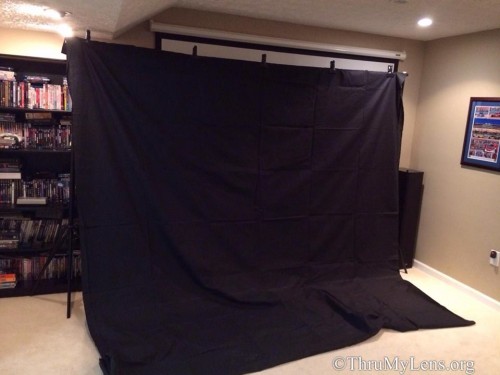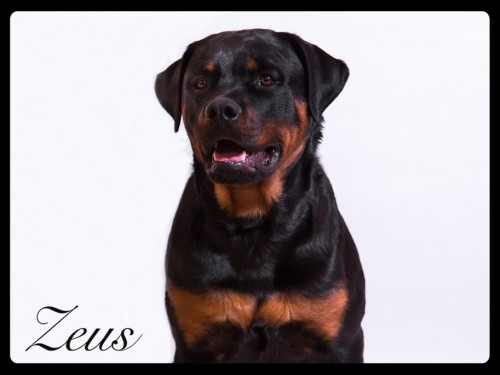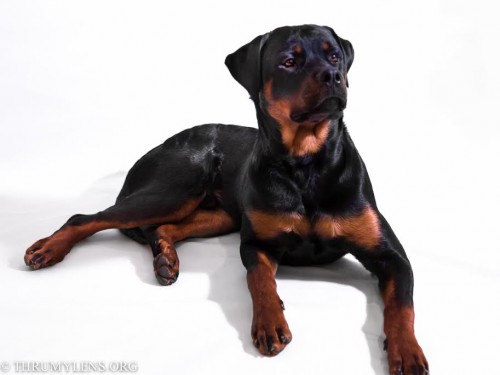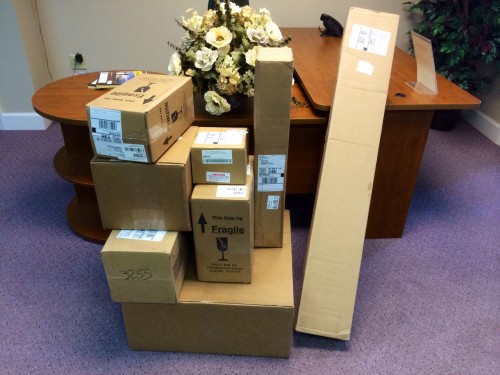The first order of business was to select a background support system. There’s a lot of choices at many different price points, but I went with a fairly mid-priced system – the JTL B-1012, 12’3″ Wide Background Support System – about $150.00. It’s basically two light stands with a pole that runs between them on which you clamp or drape a background – the photographic equivalent of a cloths line. I also bought 3 backgrounds for use with the support system. I anticipated that white would be most often used, particularly in location shoots, so it needed to be both sturdy and easily cleaned (for use with dogs and other pets). White paper and cloth were out, but this 9 X 20 White Vinyl Photo Backdrop Background seemed quite ideal for my purposes. It’s a bit heavy though and not easily thrown in the back of the car. In addition to the white vinyl, I bought a black cloth, and a blue cloth background, and several clamps to keep the backgrounds from sliding off the support system – all of which totaled about $230.00. Added to the cost of the support system, my grand total was up to about $380.00. Here’s a photo of the support system which the black cloth background I ordered set up in my basement home theater room.
Now I had to move on to the real expense – lights, triggers, and modifiers.
The first decision I had to make was the type of studio lights was I going to use. Technically speaking, I’ve done studio photography for the luxury watch/macro product photography I’ve done but the studio has been very small. When photographing small, inanimate objects (like watches), constant source lights were sufficient. But with a larger stage for both pets and potentially their owners, I’d need to go with strobes (basically very powerful camera flashes) – particularly given how fast moving and twitchy pets can be. Quality studio strobes are hideously expensive. However, the name that kept coming up over and again in terms of value, performance, and customer service is Paul Buff. Paul Buff studio strobes are the stuff of legends – White Lightning, Alien Bees, and most recently, the Einstein E640. I wanted to get three lights. One to use as a key light, one potentially for a hair light, and one potentially to use to light my white vinyl background. The placement possibilities are nearly endless, but three matching output lights provides a lot of flexibility. Now technically speaking, it is possible to do “studio work” with just off-camera flash guns (as I proved below). I already owned a Pocket Wizard TT5 Kit (1 transmitter, two receivers) for triggering my Canon TTL flashes. But I didn’t want to go this route for a couple of reasons. Firstly, I wanted the added flexibility and capability of studio strobes. Second, when I see photographers using off camera flash guns in a studio setting, I can’t help but think it looks cheap/unprofessional. I plan to set this studio rig up at dog shows – I want people to see my lights from across the room and say “Ooooo…look at him! He has big, professional lights! He must be good!” So I decided to go with three Einstein 640 strobes at $499.00 each.
After making the decision to go with Einstein strobes, I wrestled greatly over a triggering system. Here again, technically speaking, I probably could get by without the added expense of a triggering system. You can connect one strobe to your camera via a cable, and when it flashes, it can trigger your other strobes via photo sensitive sensors. But using a radio controlled triggering system is a far more elegant solution which opens up a world of creative possibilities. Here again, Paul Buff’s Cyber Commander triggering system receives high marks from the pro-shooter community, particularly when paired with the Einstein strobes.
The only other consideration is powering the strobes. On location, I may not have access to power outlets to power my Einstein strobes. Paul Buff once again comes to the rescue with a portable power solution which as good if not better performance than what more premium solutions provide in the Vagabond Mini Lithium. This nifty little portable battery pack can be used with power strips to power multiple strobes and according to the customer service representative I spoke with, the Vagabond Mini Lithium is good for about 250 activations at full power before power is depleted. If I’m running all three of my lights, I should be able to get at least 85 shots. Additional battery packs for the Vagabond Mini Lithium can be purchased for $89.00 each.
Once I had decided on the strobe brand and model I wanted, and the triggering system, I just need a few light modifiers – accessories which help shape or diffuse the light coming from the strobes. Paul Buff makes some great modifiers which are (from an attachment standpoint) compatible with the Einstein strobes. When you order multiple Einstein strobes, you get an accessory discount, so here’s what my total order looked like:
E640 $499.95 3 Einstein E640 Studio Flash Unit
VM120* $239.95 1 Vagabond Mini Lithium 120VAC
VMBAG $14.95 1 Vagabond Mini Bag
22HOBD $79.95 1 22-inch High Output Beauty Dish
FSB1036 $119.95 1 Foldable Stripbox (10 x 36 in.)
G1036 $29.95 1 Foldable Stripbox Grid (for the FSB1036)
PLM51-BOC $14.95 2 PLM 51in Black Outer Cover
PLM51U-W $39.95 2 51-inch Parabolic Umbrella White with Buff Speedring
PLM86-WFDF $22.95 1 PLM Front Diffuser Fabric, 86in White
PLM86U-S $79.95 1 86-inch Parabolic Umbrella Extreme Silver with Buff Speedring
CC $179.95 1 Cyber Commander
CSXCV $29.95 3 CyberSync Transceiver Module
With the bundling discounts applied, my total order with Paul Buff came to $2435.09. Tack on the previously spent $380.00 for the background support system and accessories, and my total cost for assembling my studio came to $2815.09 – add in maybe another $50.00 for some other incidentals I bought like a posing stool and a travel bag for the strobes. In the grand scheme of things, that’s a number to be proud of – in the world of studio photography equipment, that cost is a drop in the bucket. More importantly, I bought an enormous amount of capability for just under $3,000.00. The DSLR camera body I shoot with (Canon 5D Mark III) has a retail price tag of $3500.00 all by itself, so again the amount I spent was very reasonable and I can potentially recoup the investment in the first couple of months of using it. Am I “done” buying equipment? Probably not, but I’ve got enough equipment and capability to produce excellent work now, and get a better perceptive about what works with the equipment I have, and what doesn’t.
As I mentioned above, I decided to take some test photos using my new background support system. My Paul Buff order hadn’t yet arrived so I tried my hand at using my Pocketwizard triggers along with my Cannon 580EX flash. For the photos below, I used a single, off-camera flash with my subject (my Rottwiler puppy Zeus – 9 mo. old) on my white vinyl background:
Right now, you may be saying, “you moron! return all those strobes and the other crap and just shoot with your flash!” The thing is, it took about an hour of shooting time and about an hour of post photo processing to get these results – primarily because there was a lack of balance in the light, and there wasn’t enough of it. That’s waaaaay too much time spent for just two photographs – it’s not a sustainable business model. I want to get the shot right “in camera” and not have to rely on Photoshop wizardry to salvage unusable photos. That’s what I’m hoping to get from my lighting gear – here’s what showed up to my office:
Hopefully tonight I can get the strobes set up and take some more practice shots.






John,
Send me your email, and I will send you some photos I think you will like.
I always enjoy your site as we share the same likes.
By the way, I think USN is awful…I’m banned there, too! No real loss for guys like us, I think not.
All the best,
Ned Redway
Presidential Photojournalist
Palm Springs, California
I’d love to see your shots! You can send to john@thrumylens.org.